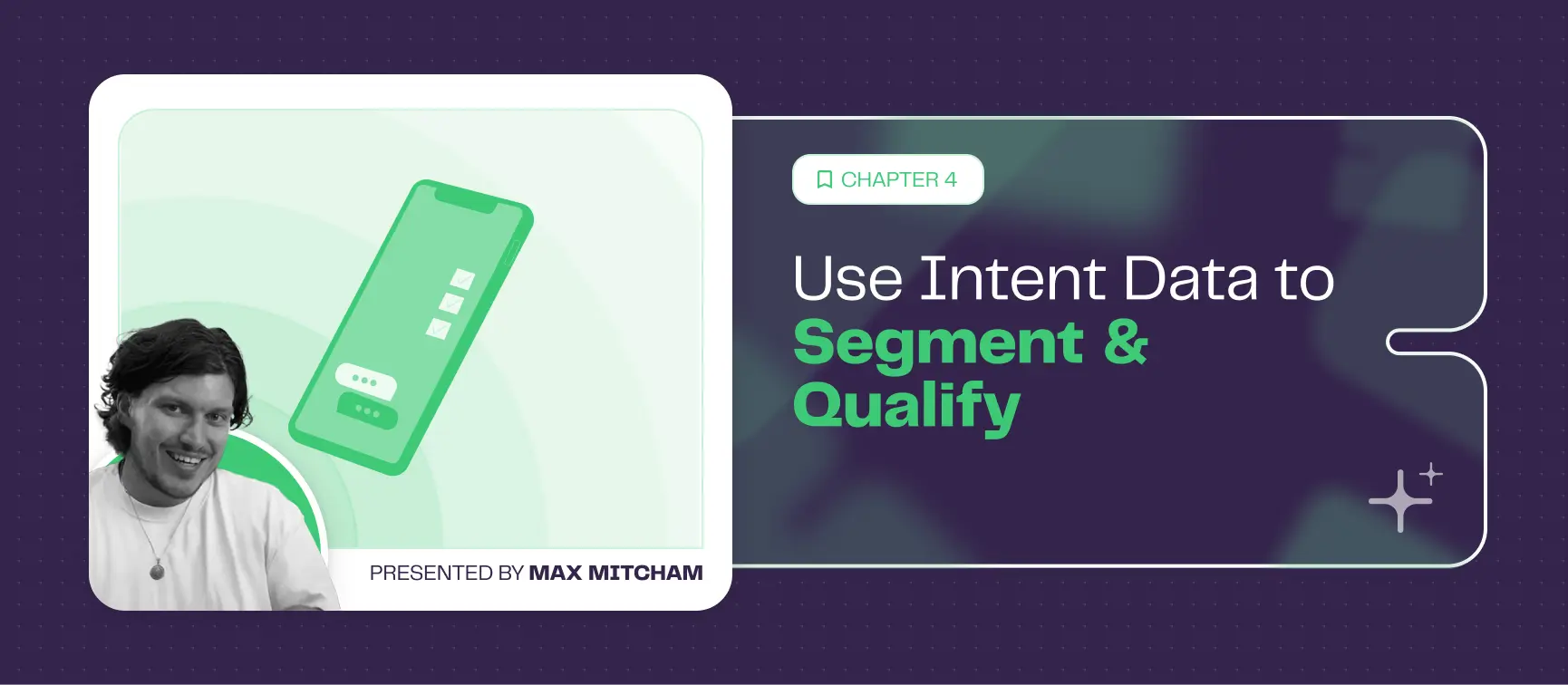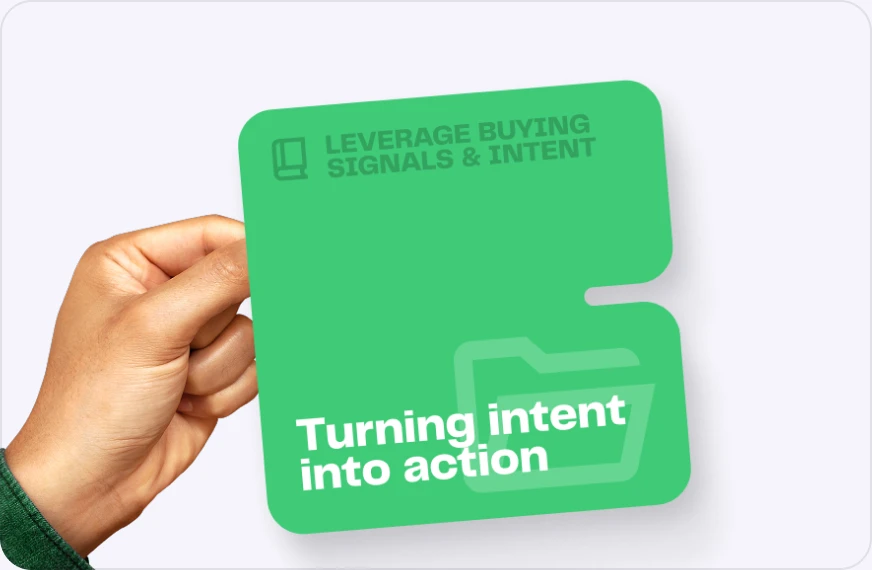
If you’ve made it this far in the academy, you already get it: not all leads are created equal. And more importantly, not all moments are the right moment.
This chapter is your blueprint for building a segmentation strategy beyond tracking signals. It’s about acting on them—with the right message, to the right person, at precisely the right time.
Let’s break it down step by step.
Step 1: Define your ICP and JTBD
First, get laser-focused on who matters most. If your ICP definition still looks like “B2B companies with 50+ employees,” go back to square one.
Your segmentation needs contextual signals, not just firmographics.
To use B2B intent data effectively, you must go beyond firmographics. Add contextual layers:
- Roles that match your use case (RevOps, PMM, CS leaders)
- Companies using complementary or competitive tools (BuiltWith, Wappalyzer)
- Recent funding activity, certifications (B Corp, ISO, SOC 2)
That’s your static layer. Now, let’s add intentionality.
Use the Jobs-To-Be-Done (JTBD) framework to shift from who they are to why they buy.
It’s not just “a VP of Sales at a SaaS company.” It’s “someone trying to hit pipeline goals without burning through reps.”
JTBD helps you segment by:
- The outcome they want
- The blockers they face
- The emotional and strategic pressures they feel
Once you know why they move, you can detect when they’re ready to.
Step 2: Identify key moments
This is where intent data becomes actionable.
List out the micro-events that happen before a purchase decision. These aren’t signals yet—they’re the context that signals will later reflect.
Some examples:
- A new Head of Sales joins a Series A startup
- A prospect tests your competitor
- A lead drops off after starting a demo request
- A company raises a new round and starts hiring like crazy
These key moments aren’t just interesting—they’re strategic flags. And they’re where your segmentation logic begins.
Step 3: Map the signals
Operationalize your insights. Match key moments with first-party and third-party intent data to build your signal matrix.
Let’s take one example:
This is the heart of using B2B intent data: linking what they do to why you act.
Step 4: Tag signals by heat level
This is where your team starts to make faster, better decisions.
For each signal, assign a heat level:
- Hot: “Contact now” (e.g., tested a competitor, searched migration guide)
- Warm: “Nurture sequence” (e.g., attended your webinar, downloaded a report)
- Cold: “Monitor + enrich” (e.g., joined a LinkedIn group, viewed one page)
Why it matters: Not every signal deserves a salesperson’s time. Heat levels help route leads automatically—whether to SDRs, nurture campaigns, or predictive scoring engines.
Step 5: Collect the data
Now connect the pipes and make your strategy actionable.
Tools that help:
- LGM: Connect all of the above and activate the workflows
- LinkedIn Sales Navigator: signal detection, job change alerts, funding, hiring
- Clay + Buska: post-engagement, custom signal triggers
- BuiltWith / Wappalyzer: track tech stack shifts
- Mantiks / Google Alerts: funding, hiring, public intent
- Trigify: real-time intent signals from B2B data and company events
- RB2B / Vector: behavioral tracking on your site
How to operationalize:
- Set tracking criteria per signal family (e.g., job changes vs. tech adoption).
- Define alert thresholds (“trigger outreach when 3+ signals fire”).
- Pipe into your CRM → create views per heat level or ICP segment.
- Launch multichannel sequences via LGM based on heat + JTBD profile.
You’re not just collecting data. You’re activating intent.
How to use intent signals in an Allbound strategy
So now you’ve got the matrix. You’ve got the tools. What next?
Intent signals only pay off when they guide action.
Here’s how to use intent data to drive conversion in an Allbound motion:
1. Enrich the experience
Use high-value content to match the signal:
- Downloaded comparison? Send content that proves you are better than your competitors.
- Tested competitor? Offer switch guides and proof points.
- Engaged with a hiring signal? Reference team scaling challenges.
2. Score and prioritize
Use the signal heat + behavior scoring model to rank leads. The next module covers this in-depth, but get ready to think like a growth analyst, not just a content team.
3. Focus on commercial resources
No more guessing who gets a call. Route leads by signal. Automate the low-value. Humanize the high-value.
4. Strike at the right time
“Right buyer, wrong time” = lost opportunity.
“Right buyer, right signal, right sequence”? That’s Allbound magic.
Takeaways
Precision beats volume. Here’s how to shift from generic outreach to laser-focused action:
- Start with clarity. Your ICP isn’t “B2B with 50+ employees.” Get specific. Think roles, tools, funding, and behavior.
- Shift to JTBD. It’s not who they are, it’s why they move. Map motivations, not just demographics.
- Spot the moments. New execs, funding rounds, tech shifts aren’t trivia; they’re timing triggers.
- Build your signal matrix by combining first-party data (web visits, downloads) with third-party intent (job changes, social activity).
- Tag by heat. Hot = act now. Warm = nurture. Cold = watch. Route accordingly, automate smartly.
- Connect the pipes. Use tools like LGM, Clay, and Sales Nav to unify and activate your data stack.
- Let signals guide action. Match the message to the moment. Use your content like a scalpel, not a megaphone.
- Think ops, not hope. Define thresholds, set alerts, trigger sequences, and treat segmentation like a system.
The right person. The right time. The right play. Every single time.
Stop chasing. Start converting.



